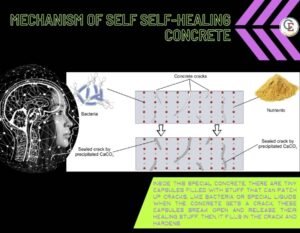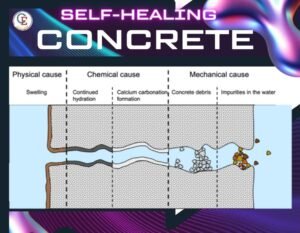Hey there, fellow builders and curious minds! Today, I want to talk about something that sounds straight out of a science fiction movie but is very much a reality: self-healing concrete. Yep, you read that right – concrete that can heal itself!
Let assume you’re walking down the street, admiring the beautiful buildings around you, when suddenly you notice a crack in the sidewalk. That tiny crack might seem innocent, but over time, it can grow into a big problem, leading to costly repairs and safety hazards.
But fear not, because self-healing concrete is here to save the day. So, what exactly is this magical material? Well, it’s just like regular concrete, but with a special twist it can repair its own cracks without any human intervention.
Self-healing concrete is like regular concrete, but it has a superpower – it can fix itself. Inside this special concrete, there are tiny capsules filled with stuff that can patch up cracks, like bacteria or special liquids. When the concrete gets a crack, these capsules break open and release their healing stuff. Then, it fills in the crack and hardens, just like your body healing a cut. This self-healing ability makes the concrete stronger and helps it last longer.
Self-Healing Concrete : The Promise of Building Better
Self-healing concrete isn’t just a fancy innovation it is a game-changer for the construction industry. Here’s why:
Durability: By repairing cracks as soon as they form, self-healing concrete helps prevent further damage and extends the lifespan of buildings and infrastructure.
Safety: Cracks in concrete can pose serious safety risks, especially in structures like bridges and highways. Self-healing concrete helps maintain structural integrity and reduces the likelihood of accidents.
Cost-Effectiveness: While self-healing concrete may be slightly more expensive. But, it can save a ton of money in the long run by reducing the need for frequent repairs and maintenance.
Sustainability: By minimizing the need for repairs and replacements, self-healing concrete helps reduce waste and conserve resources, making it a more environmentally friendly option.
Well, like any new technology, self-healing concrete still has some limitations and challenges to overcome. For example, it may not be suitable for all types of structures or environments, and more research is needed to improve its effectiveness and cost-efficiency.
But despite these challenges, the future looks bright for self-healing concrete. With ongoing advancements in materials science and engineering, we’re getting closer to a world where cracked sidewalks and crumbling buildings are a thing of the past.
So, the next time you see a crack in the concrete, don’t despair – just remember that self-healing concrete is on the way to make our world safer, more durable, and more sustainable than ever before. Here’s to building a better future, one crack at a time!
Mechanism of self Self-Healing Concrete
So, in a nutshell, self-healing concrete works by using special ingredients to automatically repair cracks when they appear, making the concrete stronger and more durable without the need for human intervention. It’s like having a built-in repair system for your concrete structures. Sure, let’s simplify the mechanism behind self-healing concrete:
Capsule Containment: Self-healing concrete contains tiny capsules dispersed throughout its structure.
Crack Formation: When a crack forms due to external forces or environmental factors, it breaches these capsules.
Healing Agent Release: Once the capsules are breached, they release their contents, which could be either bacteria or a healing agent such as a polymer.
Chemical Reaction or Polymer Flow: If bacteria are released, they react with the environment to produce calcium carbonate, which fills the crack as it hardens. If a polymer is released, it flows into the crack and solidifies, effectively sealing it.
Crack Repair: The chemical reaction or polymer solidification gradually fills the crack, restoring the concrete’s integrity.
Completion: Over time, the crack becomes fully sealed, and the concrete is repaired without any external intervention.
How Self-healing concrete discovered
The story of self-healing concrete starts with a clever discovery by scientists in the early 2000s.
It all began when researchers were trying to find ways to make concrete stronger and more durable. They knew that cracks were a big problem for concrete structures, so they started thinking about how to fix them automatically.
One day, while experimenting in the lab, they came up with a brilliant idea of self healing concrete. What if they could put tiny capsules filled with healing agents into the concrete?
Then, when a crack formed, these capsules would break open and release the healing agents, which would fill in the crack and make the concrete as good as new. After lots of testing and experiments, they finally made it work. They found that by adding these special capsules to the concrete mix, they could create a material that could repair itself when damaged.
The discovery of self-healing concrete was a game-changer for the construction industry. It meant that buildings, bridges, and roads could stay strong and safe for much longer without needing expensive repairs.
Since then, scientists and engineers have been working hard to improve self-healing concrete and find new ways to use it. Today, it’s becoming more and more common in construction projects around the world, helping to build a future where our infrastructure is stronger, safer, and more sustainable. And it’s all thanks to a little bit of ingenuity and a whole lot of science. Here are some examples of structures and their locations where self-healing concrete has been used:
Bridge: A bridge in the Netherlands.
Highway: Portions of a highway in Japan.
Tunnel: Tunnel projects in Norway and the United States.
Building: A commercial building in Germany.
Coastal Structure: Seawalls in South Korea.
Underground Parking Garage: Parking garage in the United States.
Feel free to follow us there on Instagram and drop a comment to say hello!



